I really enjoy raising guppy fish. They have vibrant personalities and unique behaviors, making them a wonderful addition to various fish tanks.
When I initially began keeping guppies, I had numerous questions. How should I care for them? What’s the ideal setup for their tank? What water conditions do they require?
In this article, I’ve compiled a complete guide for caring for guppy fish. I’ll go over all the basics, from beginning to end, to ensure your guppy gets the excellent care it deserves.
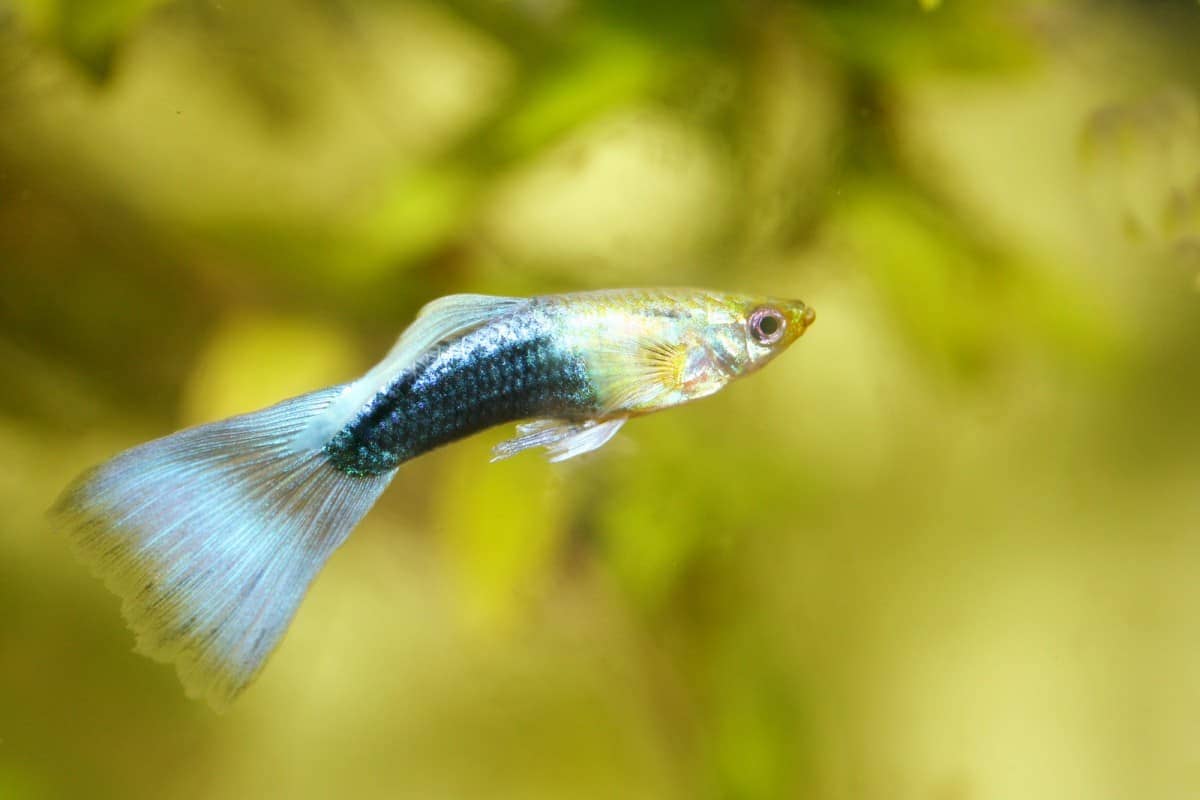
Before we begin, here’s a simple table summarizing what I am about to discuss:
| Care Aspect | Summary |
| Tank Size | Minimum 10 gallons; 1-2 gallons per guppy |
| Temperature | 72°F – 82°F; stable with an aquarium heater |
| Water Acidity (pH) | Ideal pH: 7.0 – 7.2 |
| Ammonia/Nitrite/Nitrate | Regular testing; Ammonia & Nitrite at 0 ppm, Nitrate < 20 ppm |
| Heater | 3-5 watts per gallon; fully submersible |
| Air Pump/Bubbler | Essential for oxygenation and water circulation |
| Filter | Hang-on-back or sponge filter; supports beneficial bacteria |
| Plants | Live plants for natural environment & water quality |
| Light | 8-10 hours per day; use LED lights |
| Hiding Spots | Caves, driftwood, dense plants for stress reduction |
| Food Type | Flake foods, live foods (brine shrimp, daphnia), vegetable matter |
| Feeding Amount | Small quantities they can consume in 1-2 minutes |
| Feeding Frequency | Adult Guppies: 2-3 times a day; Juveniles: 3-4 times a day |
Guppy Fish: Quick Overview
Guppy fish are a popular choice in home aquariums for their vibrant colors and ease of care.
They’re ideal for both beginners and experienced aquarists, offering a lively and visually appealing experience.
- Origins: Native to Northeast South America, guppies have been bred globally, resulting in a wide variety of colors and fin shapes.
- Behavior: These social, active fish are livebearers, known for swimming in groups and giving birth to free-swimming fry.
- Appearance: Guppies boast a range of bright colors and patterns, with males typically more vivid and smaller than females.
- Requirements: They prefer warm, clean water (around 72-82°F) with a pH of 7.0-7.2 and require a well-filtered aquarium.
- Lifespan: Guppies generally live for 1-2 years, but with optimal care, they can survive up to 5 years in a home aquarium.
- Diet and Feeding: Omnivorous by nature, they thrive on a diet of flake foods, brine shrimp, and bloodworms, fed once or twice daily.
- Compatibility: Guppies are peaceful and can coexist with other non-aggressive fish, making them suitable for community tanks.
Also Read: 21 Facts About Guppies
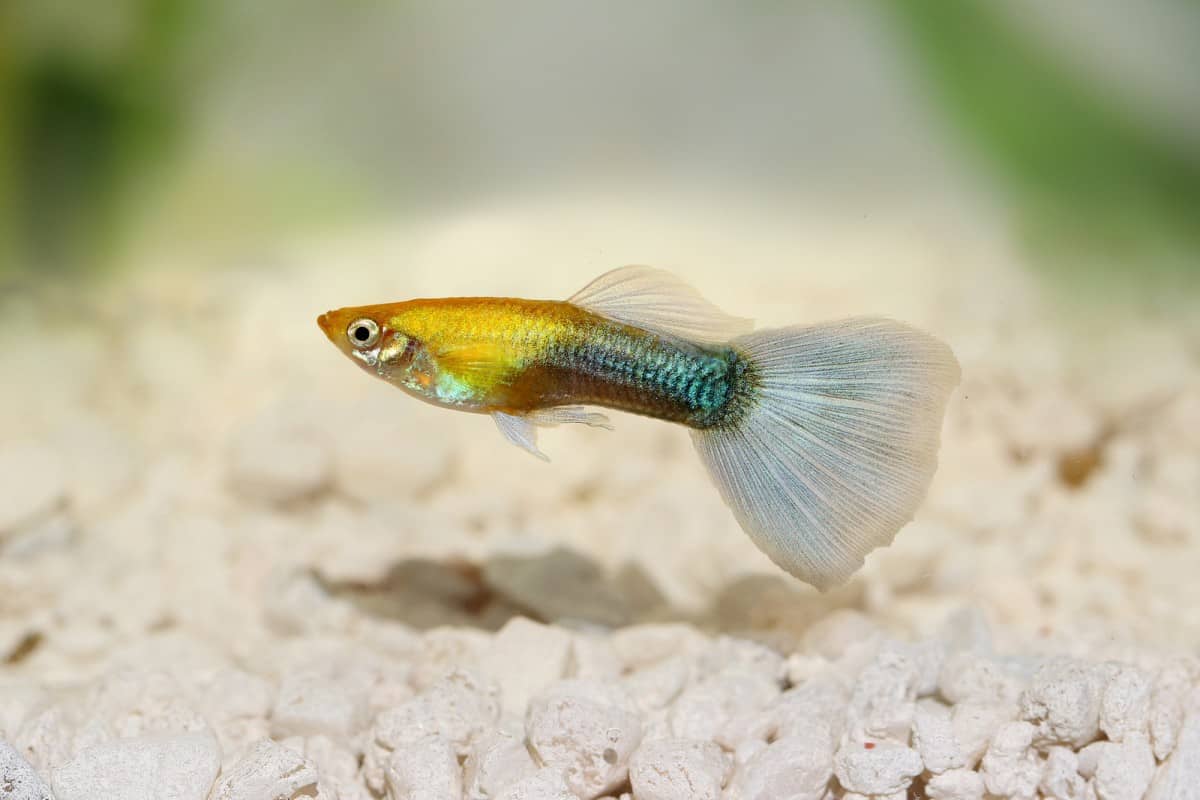
Common Types of Guppies
Guppies come in an array of types, distinguished by their tail shapes and color patterns.
These varieties showcase the breed’s diversity and adaptability in different aquarium settings.
- Fancy Guppies: Known for their elaborate tails and vibrant colors, fancy guppies are a favorite among hobbyists for their aesthetic appeal.
- Endler’s Guppies: Smaller and less flashy than fancy types, Endler’s guppies are valued for their hardiness and natural, wild-type appearance.
- Delta Tail Guppies: These guppies feature a triangular tail, resembling the Greek letter delta, and are admired for their symmetrical fin shape.
- Veil Tail Guppies: Recognizable by their long, flowing tails, veil tail guppies add a touch of elegance to any aquarium.
- Round Tail Guppies: As the name suggests, these guppies have a rounded tail fin, offering a simple yet charming look.
- Swordtail Guppies: Unique for their extended lower tail fin, resembling a sword, these guppies are a visually striking choice for enthusiasts.
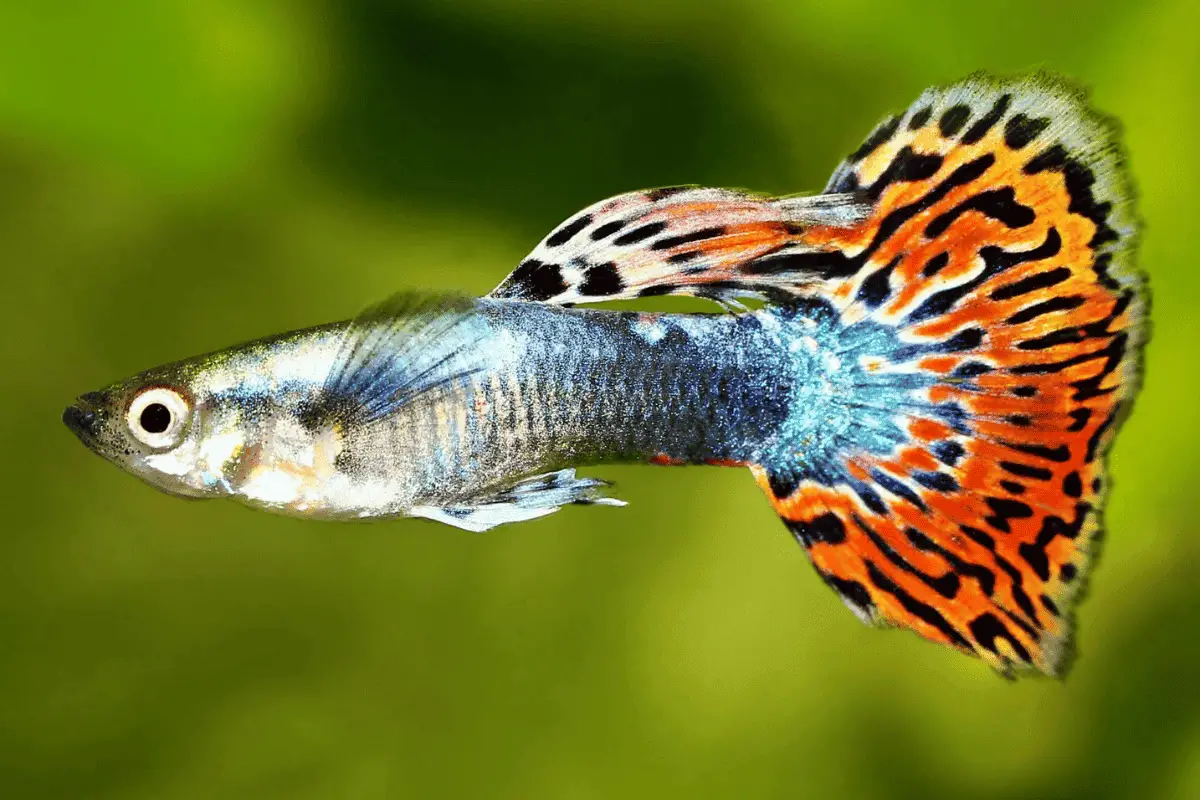
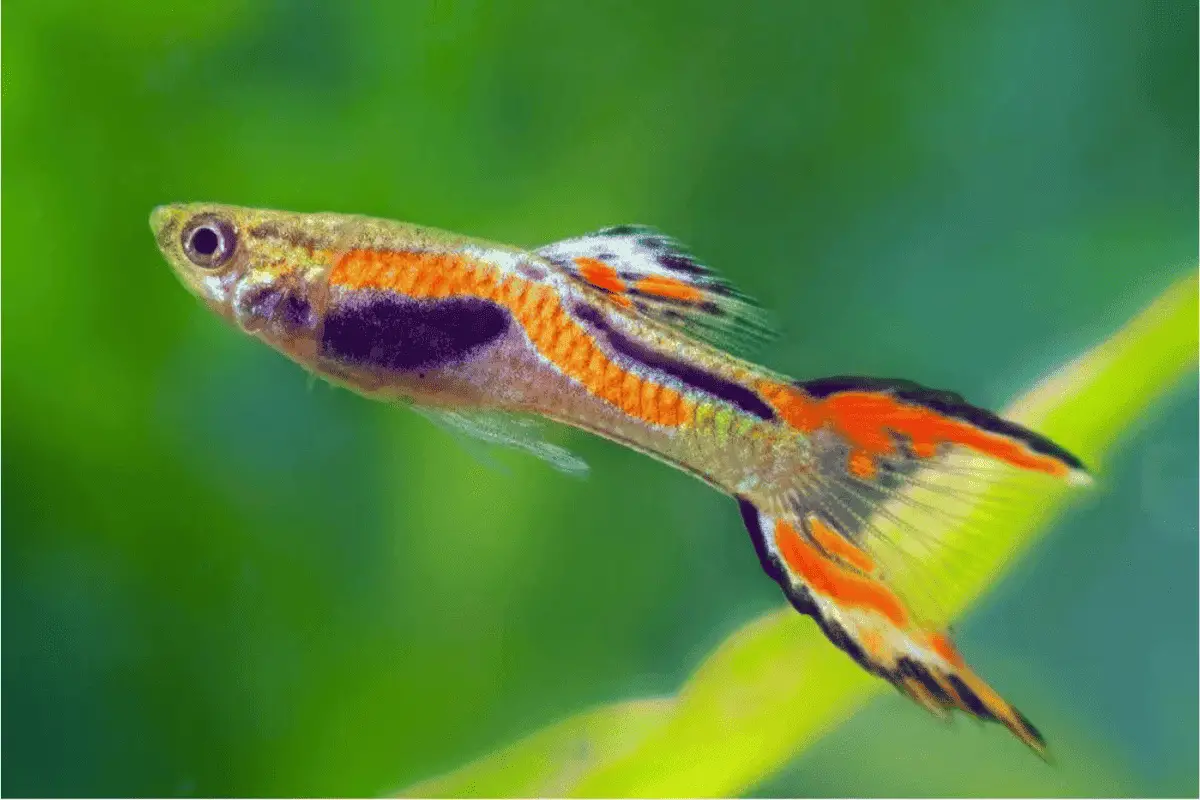
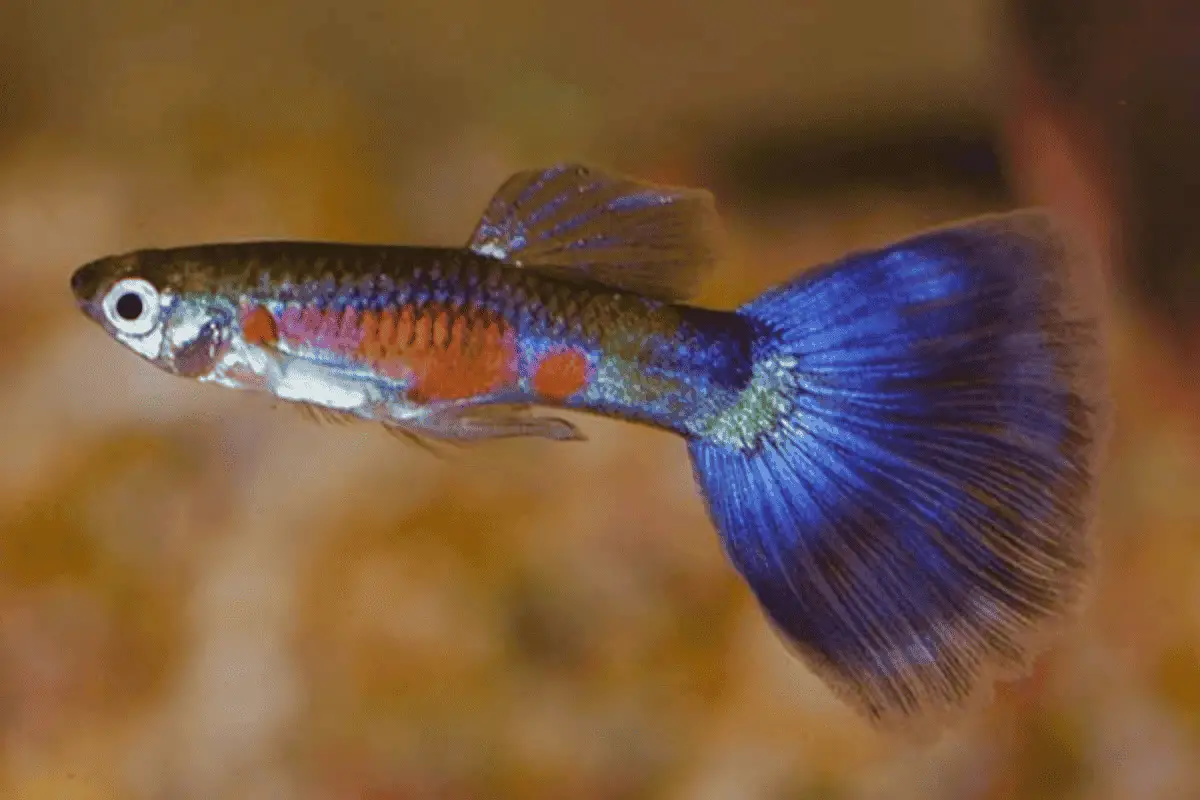
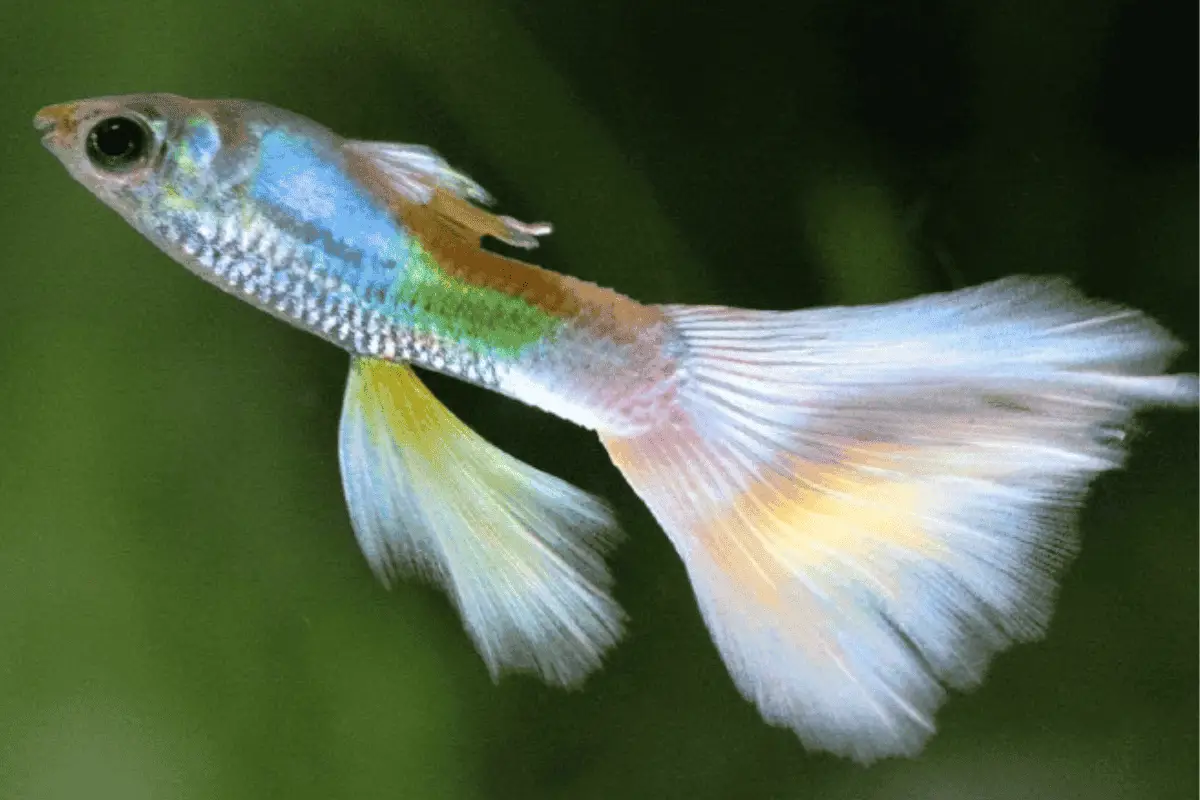
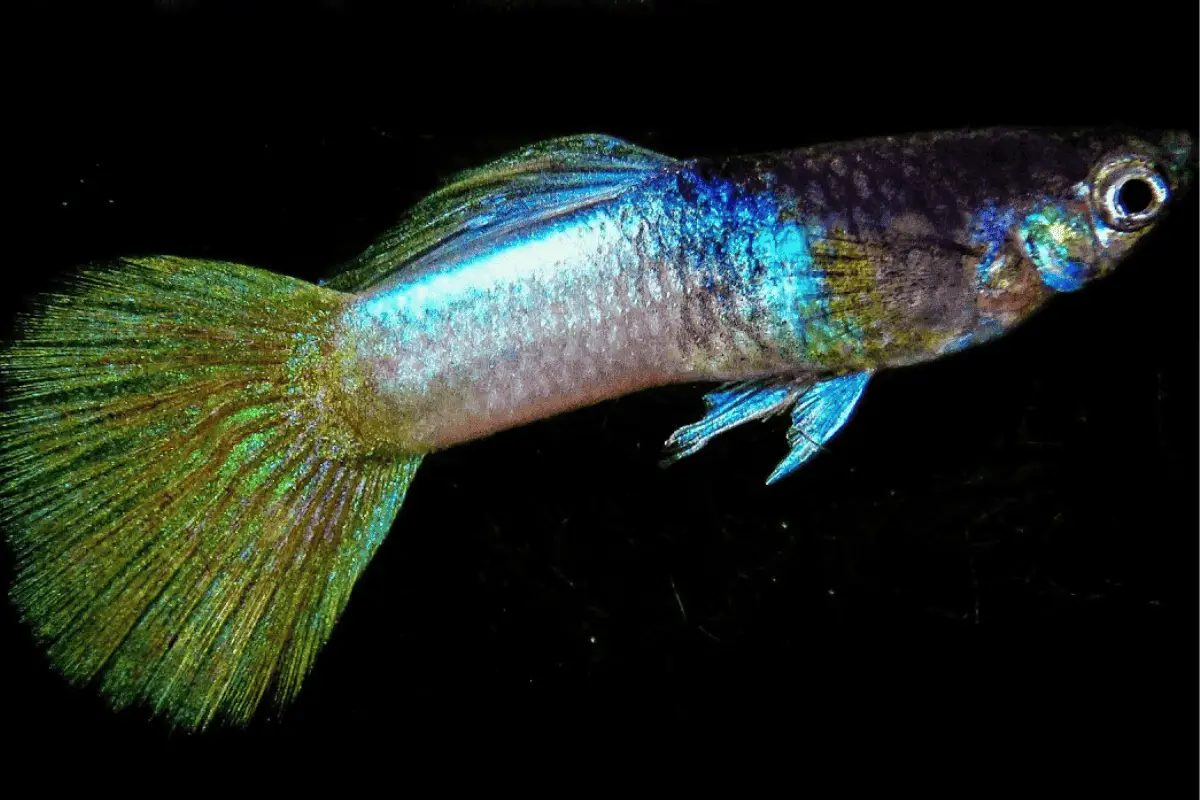

How to Care for Guppies
Let’s begin by exploring the essential care requirements for guppy fish, starting with how to set up their tank properly:
Guppy Fish Tank Setup
1. Tank Size
Guppies are active swimmers and require adequate space. The tank size affects their health and behavior significantly.
- Minimum Size: A 10-gallon tank is ideal for a small group of guppies, allowing enough room for swimming and exploration.
- Space per Fish: Allocate 1-2 gallons of water per guppy to prevent overcrowding, which can lead to stress and health issues.
- Group Dynamics: Guppies thrive in groups; a 10-gallon tank can comfortably house 5-6 guppies, maintaining a healthy social environment.
- Larger Tanks: For larger groups, a 20-gallon tank provides more stable water conditions and room for additional tank mates.
2. Temperature
Maintaining the right temperature is crucial for guppy health, as they are tropical fish and sensitive to temperature fluctuations.
- Ideal Range: Keep the water temperature between 72°F and 82°F to mimic their natural tropical habitat conditions.
- Stability: Use a reliable aquarium heater to maintain a consistent temperature, avoiding sudden changes that can stress the fish.
- Thermometer Use: Regularly monitor the temperature with an aquarium thermometer to ensure it remains within the ideal range.
- Heater Capacity: Choose a heater with the appropriate wattage for your tank size; generally, 3-5 watts per gallon of water.
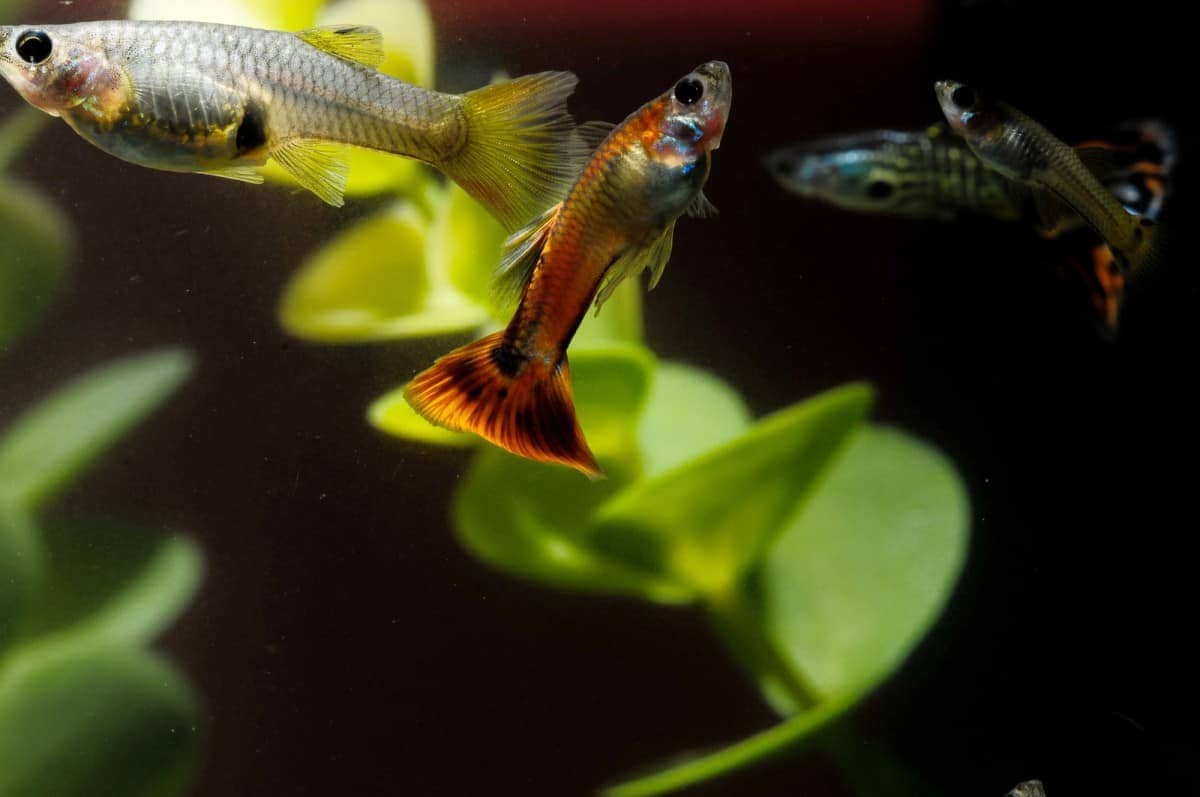
3. Water Acidity
The pH level of the water is vital for the health and comfort of guppies, affecting their biological processes.
- Ideal pH Level: Aim for a pH level between 7.0 and 7.2, which is close to neutral and suitable for guppies.
- Testing Kits: Use a reliable pH testing kit to regularly check the water’s acidity and make adjustments as needed. My recommendation: API Freshwater Master Test Kit (link to Amazon).
- pH Stability: Avoid sudden changes in pH levels by introducing any new water slowly and treating it if necessary.
- Natural pH Modifiers: Consider using natural methods, like driftwood or peat moss, to gently adjust and stabilize the pH level.
4. Ammonia, Nitrite, Nitrate
Monitoring and controlling the levels of ammonia, nitrite, and nitrate is critical for maintaining a healthy tank environment.
- Regular Testing: Test for ammonia, nitrite, and nitrate levels weekly using aquarium test kits to ensure they stay within safe limits.
- Ammonia and Nitrite: These should always be at 0 ppm, as even small amounts can be harmful to guppies.
- Nitrate Control: Keep nitrate levels below 20 ppm; higher concentrations can stress and harm the fish.
- Water Changes: Perform regular water changes (about 25-30% weekly) to manage and reduce the build-up of these compounds.
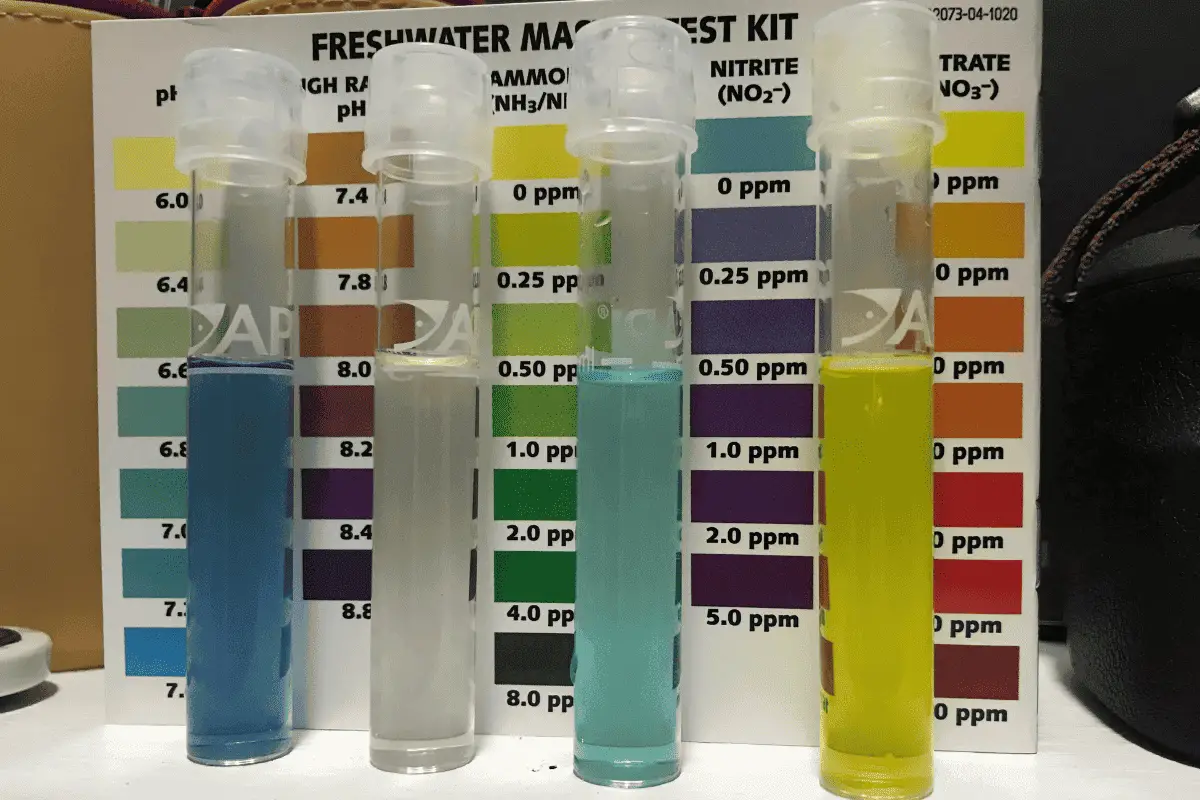
5. Heater
A reliable heater is essential in a guppy tank to maintain a stable and suitable temperature for these tropical fish.
- Heater Sizing: Choose a heater with a wattage suitable for your tank size; generally, 5 watts per gallon is a good rule. I went with the Fluval E300 Advanced Heater (link to Amazon).
- Submersible Heaters: Opt for a fully submersible heater for more consistent heating and easier temperature management.
- Heater Placement: Position the heater close to the water flow (like near the filter outlet) for even heat distribution.
- Safety Measures: Ensure the heater has safety features like automatic shut-off in case of overheating or water level drops.
6. Air Pump, Bubbler
An air pump and bubbler are essential in a guppy tank to ensure proper oxygenation and water circulation.
- Oxygenation: Air pumps increase oxygen levels in the water, vital for guppy health, especially in densely stocked tanks.
- Water Movement: Bubblers help circulate water, preventing stagnant areas and promoting a healthier tank environment.
- Size and Flow: Choose a pump and bubbler suitable for your tank size; too strong a flow can stress guppies.
- Noise Level: Opt for a quieter air pump to reduce stress for both the fish and the aquarium keeper. The Hygger Aquarium Air Stone (link to Amazon) excels in this regard.
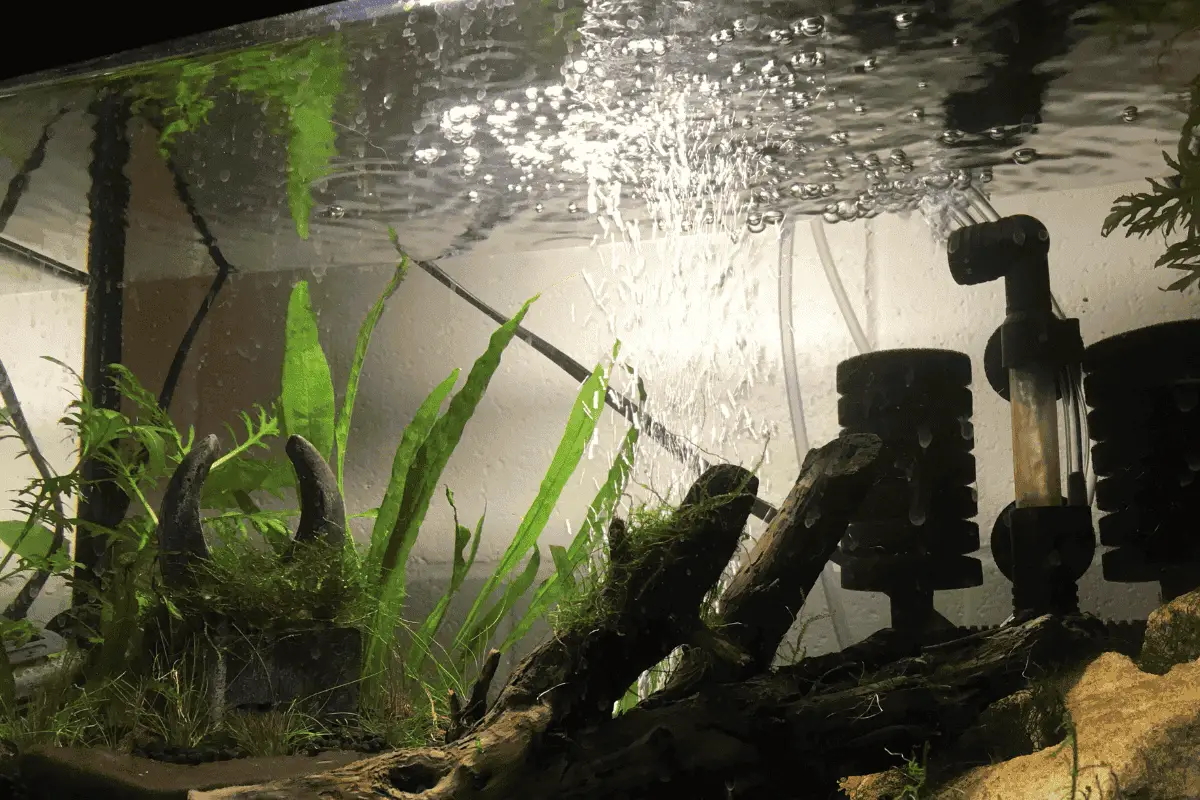
7. Filter
A good filtration system is key to maintaining clean and healthy water conditions for guppies.
- Filter Type: A hang-on-back or sponge filter is ideal for guppy tanks, providing efficient filtration without strong currents. My recommendation: Fluval C4 Power Filter (link to Amazon).
- Biological Filtration: Ensure your filter supports beneficial bacteria, crucial for breaking down harmful ammonia and nitrite.
- Regular Maintenance: Clean the filter regularly but avoid over-cleaning, as this can disrupt the beneficial bacteria.
- Flow Rate: The filter’s flow rate should be appropriate for the tank size, ideally filtering the tank’s volume several times per hour.
8. Plants
Live plants not only enhance the aesthetic of a guppy tank but also contribute to a healthier environment.
- Natural Environment: Plants mimic natural habitats, providing shelter and comfort to guppies.
- Water Quality: Plants help absorb nitrates and other waste products, improving overall water quality.
- Plant Choices: Opt for hardy plants like Java Fern or Anubias, which thrive in guppy tank conditions.
- Placement and Care: Arrange plants to create open swimming spaces and shaded areas, and trim regularly to maintain health.
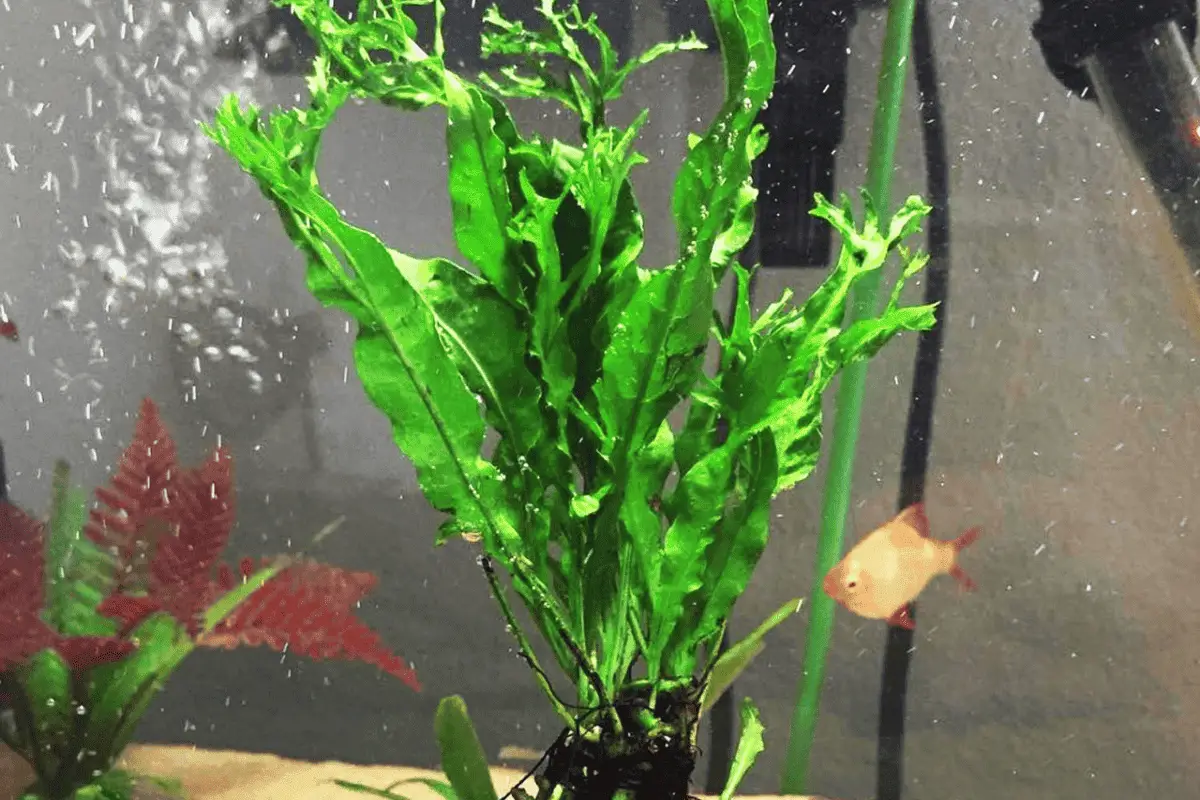
9. Light
Proper lighting is crucial for both the health of the guppies and the growth of live plants in the tank.
- Natural Cycle: Aim for 8-10 hours of light per day to mimic natural light cycles, which is beneficial for fish and plant health.
- LED Lights: Use LED aquarium lights for energy efficiency and better control over light intensity and spectrum.
- Avoid Overlighting: Too much light can lead to algae growth; use a timer to maintain consistent light cycles.
- Light Placement: Ensure even distribution of light, especially in planted tanks, for uniform plant growth and visibility.
10. Hiding Spots
Providing hiding spots in a guppy tank is essential for their sense of security and stress reduction.
- Stress Reduction: Hiding spots offer refuge for guppies, especially important in community tanks or during breeding.
- Decor Options: Use decorations like caves, driftwood, or dense plant areas to create natural hiding places.
- Avoid Sharp Edges: Ensure all decorations are smooth and safe for guppies to prevent injuries.
- Balanced Design: Arrange hiding spots thoughtfully, allowing for both open swimming areas and secluded spaces.

How to Feed Guppies
Feeding guppies the right way is crucial for keeping them healthy and ensuring a long life.
Knowing what they should eat, how much to give them, and how often to feed them are important aspects of guppy care.
1. What do Guppies Eat?
Guppies are omnivorous and thrive on a varied diet. Providing a mix of food types ensures they receive all necessary nutrients.
- Flake Foods: High-quality flake foods should form the basis of their diet, offering balanced nutrition suitable for guppies.
- Live Foods: Supplement with live foods like brine shrimp or daphnia occasionally, which provide protein and encourage natural foraging behavior.
- Vegetable Matter: Including spirulina or blanched vegetables like zucchini and lettuce adds essential vitamins and minerals.
- Frozen Foods: Frozen foods such as bloodworms and mosquito larvae are a good occasional treat, providing additional protein and variety.
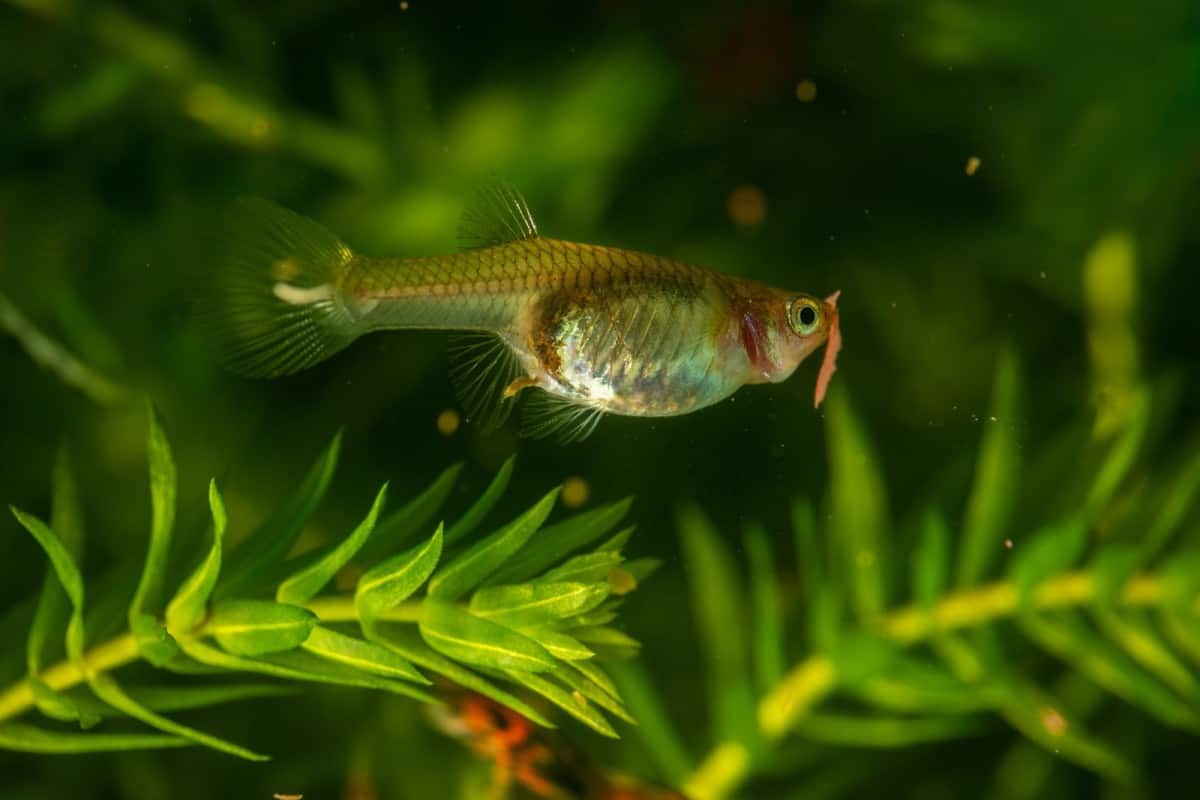
2. How Much do Guppy Fish Eat?
Overfeeding is a common issue in aquariums, leading to poor water quality and health problems. Guppies need only a small amount of food.
- Feed in Small Quantities: Provide an amount they can consume within one to two minutes, to prevent overfeeding and waste.
- Observation is Key: Regularly observe their eating habits; uneaten food should be removed to maintain water quality.
- Balanced Diet: Ensure their daily intake includes a mix of flake, live, and vegetable foods for comprehensive nutrition.
- Avoid Overcrowding: In crowded tanks, ensure all guppies get their share of food without competition or stress.
3. How Often do Guppies Eat?
Feeding frequency is important for maintaining guppies’ health. It varies with age and tank conditions.
- Adult Guppies: Feed adult guppies two to three times a day, in small amounts they can finish quickly.
- Juveniles and Fry: Young guppies require more frequent feeding, about three to four times a day, to support their rapid growth.
- Consistency is Crucial: Maintain a consistent feeding schedule to keep the fish healthy and the tank environment stable.
- Adjust as Needed: Monitor the guppies’ health and tank condition to adjust feeding frequency; less often if water quality deteriorates.
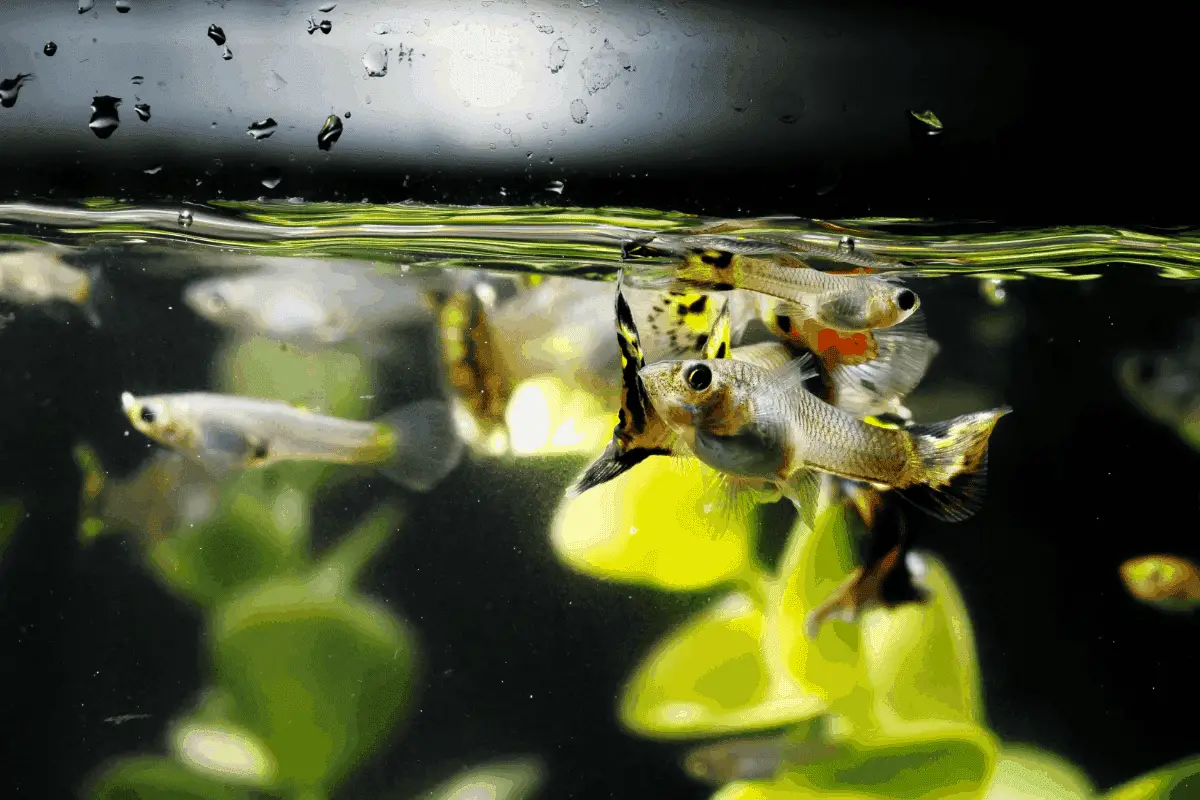
How to Pick Tank Mates For Guppies
Choosing tank mates for guppies involves considering compatibility, size, temperament, and environmental needs.
It’s crucial to select fish that can coexist peacefully with guppies and thrive in similar water conditions.
- Temperament Compatibility: Tank mates should be peaceful and non-aggressive to avoid stressing or harming the guppies. Avoid fish known for fin nipping or bullying smaller species.
- Similar Size Range: Choose fish that are similar in size to guppies; significantly larger fish might see guppies as prey, while smaller ones could be outcompeted for food.
- Matching Water Conditions: Ensure the tank mates thrive in the same water parameters as guppies, particularly in terms of temperature, pH, and hardness.
- Swimming Zone Preference: Consider fish that occupy different areas of the tank (top, middle, bottom) to reduce competition for space and resources.
- Dietary Habits: Opt for tank mates with similar dietary needs to make feeding efficient and prevent one species from dominating the food supply.
Based on that, here are a few species that can coexist with guppies:
- Neon Tetras
- Platy Fish
- Swordtail Fish
- Corydoras Catfish
- Cherry Shrimp
- Harlequin Rasboras
- Mollies
- Endler’s Livebearers
- White Cloud Mountain Minnows
- Zebra Danios
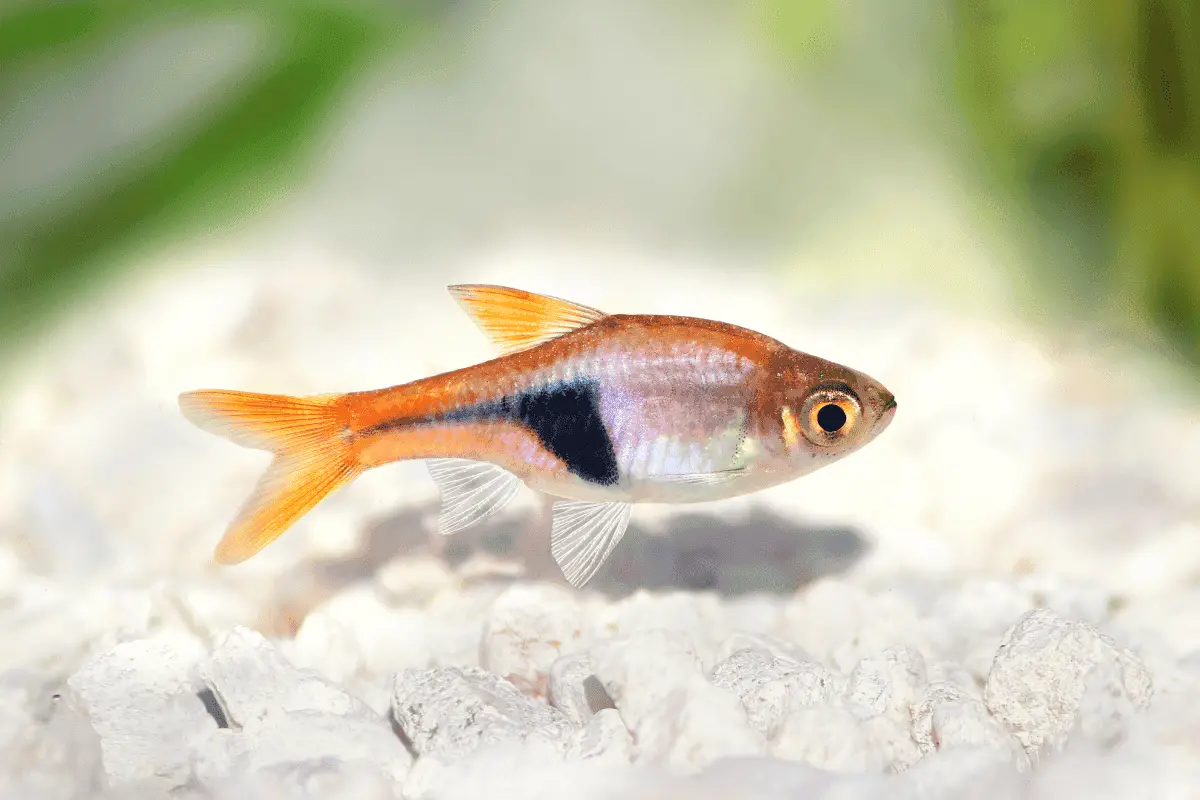
On the other hand, I would avoid species like:
- Betta Fish (Male)
- Cichlids (many types)
- Angelfish
- Arowana
- Oscar Fish
- Goldfish
- Tiger Barb
- Jack Dempsey Cichlid
- African Clawed Frogs
- Red-Tailed Shark
Also Read: Guppy Fish Tank Mates

How To Breed Guppy Fish
Breeding guppy fish successfully requires a focused approach, ensuring the health and well-being of both the adults and the resulting fry.
Creating the right conditions and monitoring the breeding process are key elements for success.
- Sex Ratio: Keep a ratio of one male guppy to every two or three female guppies to prevent females from being harassed and to increase breeding chances.
- Breeding Tank: Set up a separate breeding tank, around 10-20 gallons, to provide a safe, controlled environment for breeding and fry development.
- Optimal Conditions: Maintain the breeding tank’s temperature at 78-80°F and pH levels between 7.0-7.2, to create ideal breeding conditions.
- Healthy Diet: Feed a high-protein diet with live or frozen foods like brine shrimp to enhance fertility and overall health of the breeding guppies.
- Plant Cover: Include live plants or breeding mops in the tank to provide hiding spots for fry and reduce stress for females during and after birth.
- Monitoring: Regularly monitor the tank for signs of pregnancy in females, such as a dark gravid spot near the abdomen, and isolate pregnant females if needed.
- Post-Birth Care: After birth, remove the adult guppies from the breeding tank to protect the fry from potential predation.
Also Read: Breeding Guppy Fish

Caring For A Pregnant Guppy Fish
Caring for a pregnant guppy fish involves ensuring optimal water conditions and nutrition for the health of the mother and her fry.
This requires close monitoring and adjustments to create a safe and nurturing environment.
- Optimal Tank Conditions: Keep the water at 76-78°F and pH around 7.0-7.2. Use a reliable aquarium heater and pH testing kit, performing weekly water tests to maintain stability.
- Nutritious Diet: Feed a balanced diet of high-quality flakes or pellets twice daily, supplemented with live or frozen brine shrimp or daphnia for protein, which is crucial for fry development.
- Spacious Environment: Provide a 10-gallon tank or larger, as space is key for the pregnant guppy’s comfort. This size allows enough room for swimming and reduces stress, which can impact fry health.
- Gentle Filtration: Use a sponge filter or a filter with a low flow rate. This prevents strong currents that can stress the pregnant guppy and ensures the safety of newborn fry from being sucked into the filter.
- Plant Cover: Add live or artificial plants for hiding spots. Plants like Java Fern or Anacharis provide shelter and comfort, reducing stress and offering fry a safe place post-birth.
Also Read: Pregnant Guppy Care
How to Raise Guppy Fry
Raising guppy fry successfully involves providing them with a safe, nutritious environment that caters to their rapid growth and development.
It’s crucial to separate the fry from adult fish and ensure they receive appropriate care and nutrition.
- Separate Tank: Use a separate tank or a breeding box within the main tank to protect the fry from being eaten by adult fish.
- Optimal Conditions: Maintain the fry tank at a slightly warmer temperature, around 78-82°F, and keep the water clean with regular changes.
- Small, Frequent Feedings: Feed the fry small amounts of food 4-5 times a day to support their rapid growth, using crushed flakes or fry-specific food.
- Nutritious Diet: Include high-protein foods like baby brine shrimp or micro-worms to ensure proper development and growth.
- Gradual Introduction: Slowly acclimate fry to the main tank as they grow, ensuring they are large enough to not be seen as prey by adults.
- Regular Monitoring: Keep a close eye on the fry for signs of illness or stress, and maintain optimal water conditions to promote healthy growth.
Also Read: Guppy Fry Care
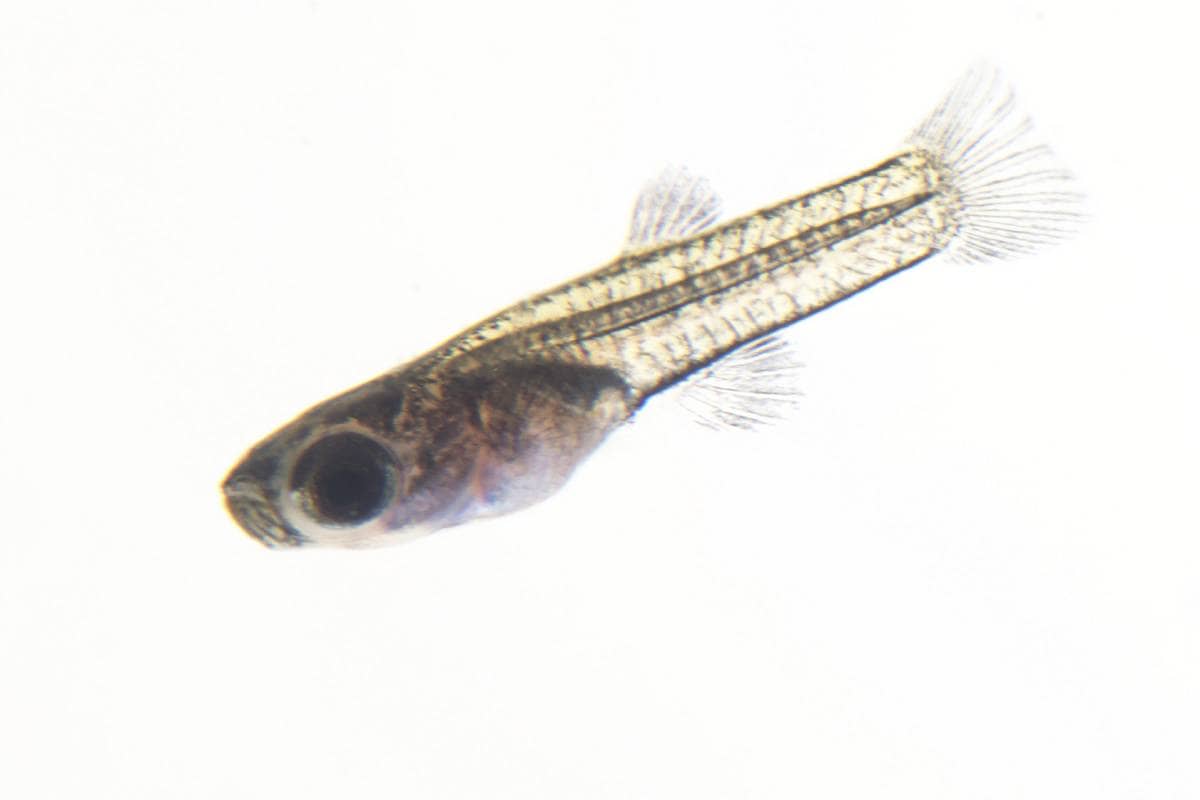
Common Guppies Diseases
Here’s a simple explanation of common diseases that can affect guppies and how to treat them:
1. Ich (White Spot Disease)
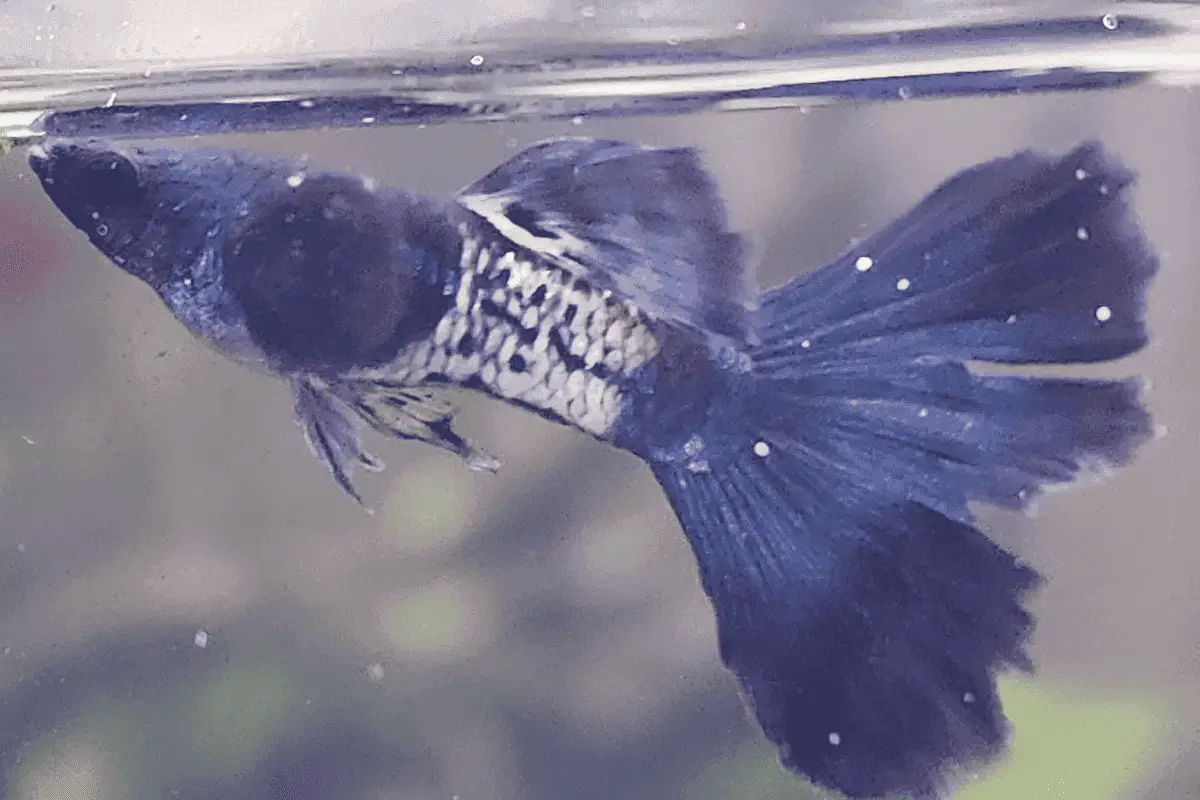
Ich is a common parasitic infection in aquarium fish, marked by distinctive white spots on the fish’s body and fins.
- Cause: Caused by the parasite Ichthyophthirius multifiliis, often thriving in poor water conditions or when fish are stressed.
- Symptoms: Look for small, white, salt-like spots on the skin, fins, and gills, alongside fish rubbing against objects due to irritation.
- Treatment: Raise the water temperature to 82°F for 3-4 days to speed up the parasite’s life cycle, and use a commercial ich treatment such as the Fritz Mardel Coppersafe (link to Amazon).
2. Tail and Fin Rot
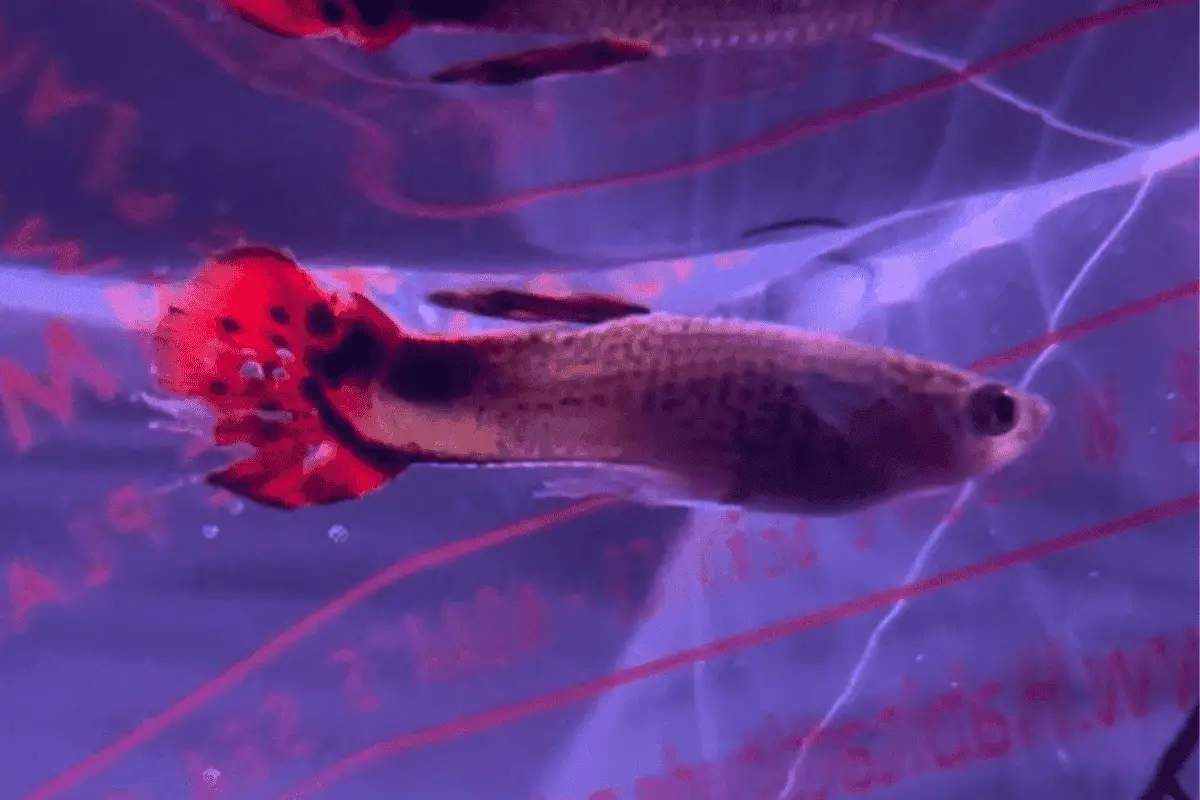
Tail and fin rot is a bacterial infection that results in the fraying or disintegration of a fish’s tail and fins.
- Cause: Often caused by poor water quality or a weakened immune system, leading to bacterial growth.
- Symptoms: The edges of fins and tail appear ragged or frayed, and may have a white, red, or black edge as the tissue deteriorates.
- Treatment: Improve water quality through regular changes and add an antibacterial medication, like erythromycin or tetracycline, following the package’s dosage guidelines.
3. Velvet Disease
Velvet disease is a parasitic infection that gives fish a dusty, velvety appearance on their skin.
- Cause: Caused by the dinoflagellate parasites (e.g., Oodinium), often occurring in overstocked or poorly maintained tanks.
- Symptoms: Fish exhibit a fine, gold or rust-colored dusting on their bodies, clamped fins, and may scrape against objects.
- Treatment: Dim the lights (the parasite requires light to thrive) and use a copper-based treatment or malachite green as per the product’s instructions.
4. Swim Bladder Disease

Swim bladder disease affects a fish’s ability to control its buoyancy, resulting in swimming difficulties.
- Cause: Can be caused by overfeeding, poor water quality, or a congenital defect affecting the swim bladder.
- Symptoms: Fish may float upside down, sink to the bottom, or struggle to maintain a normal position in the water.
- Treatment: Fast the fish for 24-48 hours and then feed a pea with the skin removed to alleviate constipation, which often helps in non-congenital cases.
5. Dropsy
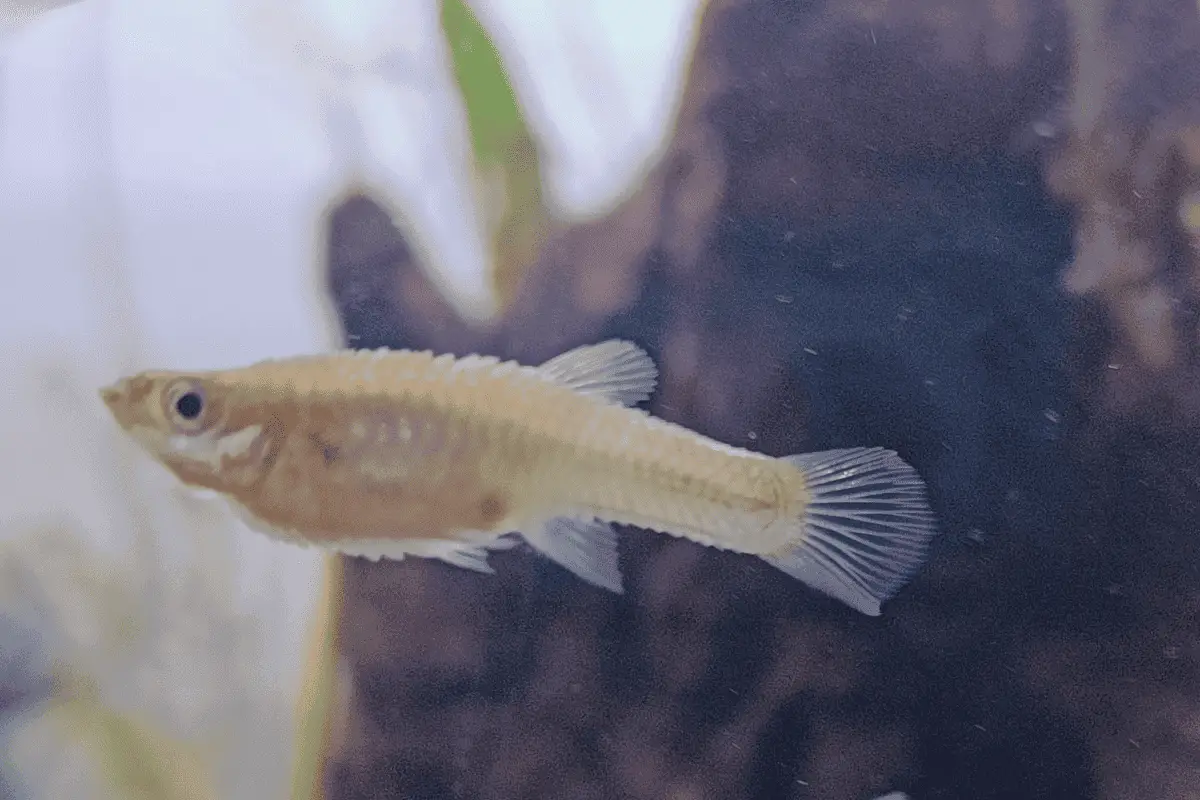
Dropsy is a symptom of a deeper issue, typically a bacterial infection, characterized by swelling of the fish’s body.
- Cause: Often caused by poor water quality or bacterial infection, leading to fluid accumulation in body tissues.
- Symptoms: Swollen belly, scales sticking out like a pinecone, and lethargy are common signs of dropsy.
- Treatment: Improve water quality and use a broad-spectrum antibiotic like Kanamycin, dosing as per the instructions, while understanding the prognosis is often poor.
Also Read: Guppies Diseases
Identifying And Treating Stressed Guppies
Recognizing signs of stress in guppies is key to ensuring their well-being and preventing potential health issues.
Stress can be indicated by changes in their behavior, appearance, and overall activity.
- Loss of Color: Stressed guppies may exhibit faded colors; vibrant hues diminish, indicating discomfort or a suppressed immune system.
- Clamped Fins: A guppy with clamped fins, where they hold their fins close to the body, is often a sign of stress or illness.
- Reduced Appetite: When guppies show a lack of interest in food or stop eating altogether, it’s a clear sign they’re experiencing stress.
- Hiding Behavior: Constant hiding or avoiding other fish and activity in the tank can be a reaction to stress or feeling threatened.
- Erratic Swimming: Look for unusual swimming patterns like darting quickly, swimming at the surface, or gasping for air as signs of distress.
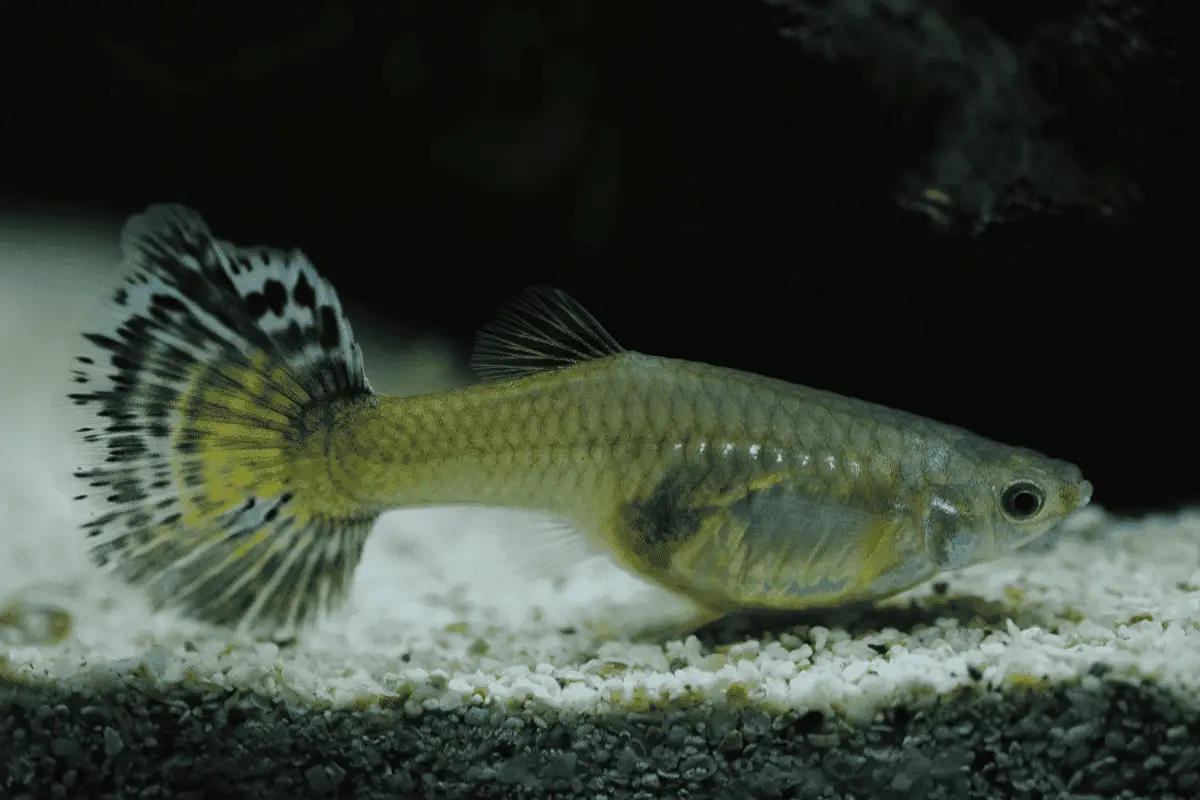
Here are some helpful methods I’ve discovered to reduce stress in guppy fish:
Alleviating stress in guppies involves adjusting their environment and care to address the underlying causes.
Proper tank management and attentive care are crucial for reducing stress levels.
- Improve Water Quality: Regularly change 20-30% of the tank water weekly, maintain a stable temperature (72-82°F), and keep pH levels between 7.0-7.2.
- Reduce Overcrowding: Provide ample space for each guppy, following the guideline of 1-2 gallons of water per fish to prevent stress from overcrowding.
- Adjust Feeding Practices: Offer small, balanced meals 2-3 times a day, ensuring food variety like flakes, live, or frozen foods to maintain health.
- Enrich Environment: Create a stimulating environment with plants, hiding spots, and mild water flow to mimic natural habitats and reduce stress.
- Monitor Tank Dynamics: Regularly observe interactions among fish; if bullying occurs, consider reorganizing the tank or separating aggressive fish.
Also Read: Stress In Guppy Fish
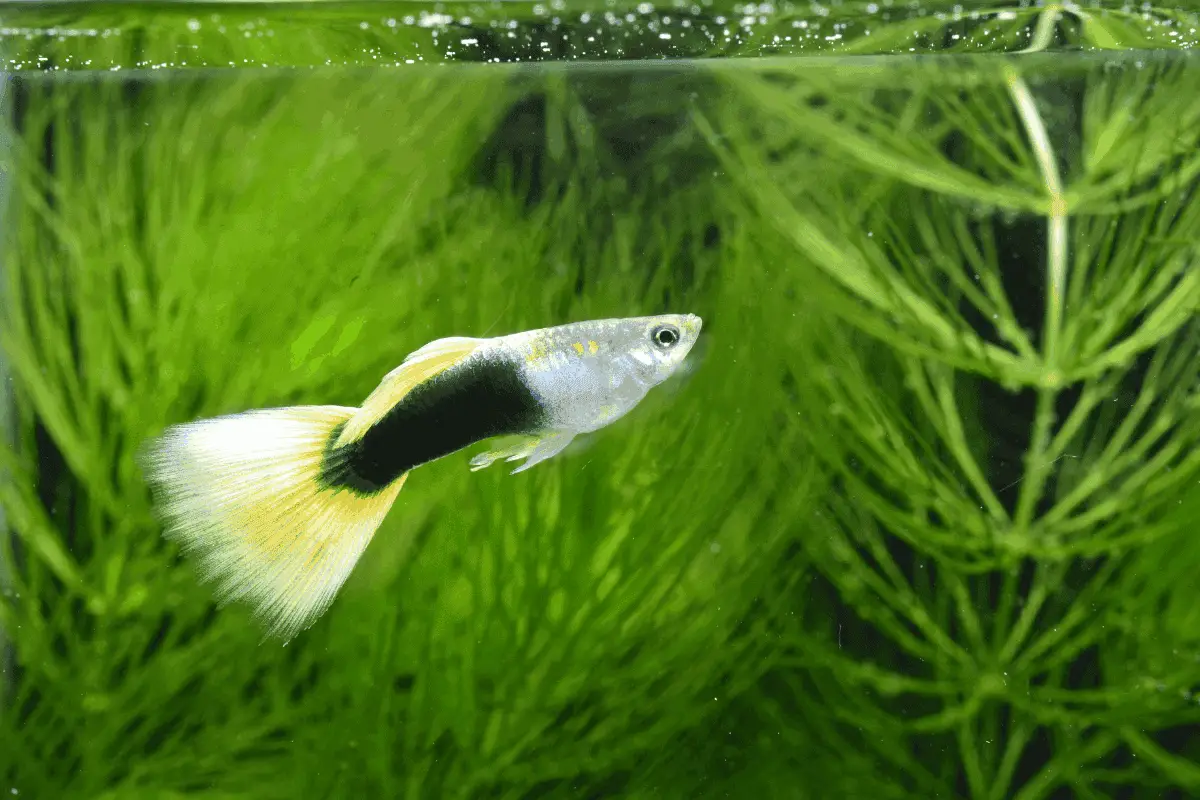
Conclusions
For quick readers, here’s a short summary:
- Guppy fish are ideal for both novice and seasoned aquarists, known for their vibrant colors, social behavior, and relatively simple care requirements.
- They thrive in warm, clean water, with specific conditions like a pH of 7.0-7.2, and require a well-filtered tank, with a preference for livebearing and group swimming.
- Guppies have a diverse diet, feeding on flake foods, brine shrimp, and bloodworms, and they can live up to 5 years with optimal care.
- Compatible with other non-aggressive fish, guppies are suitable for community tanks and come in various types like Fancy, Endler’s, and Swordtail Guppies.
- Proper guppy care involves a well-set-up tank, balanced diet, and careful selection of tank mates, and attention to breeding and fry care is essential for their propagation.
